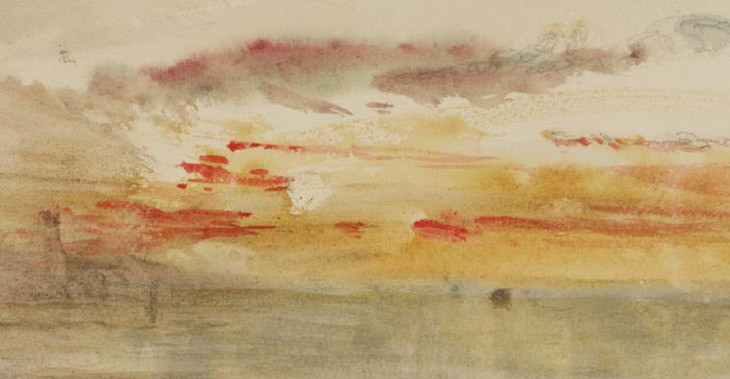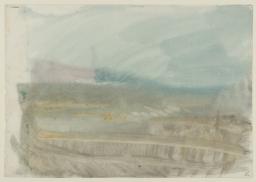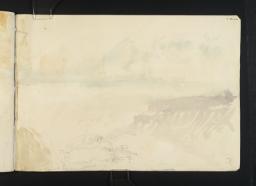Spring Tour of Northern France 1845

The Tour de Croy at Wimereuex Sketched from Ambleteuse 1845
(from the Ambleteuse and Wimereux sketchbook)
From the entry
In early May 1845, Turner made the short journey to Boulogne, northern France in a bid to escape the mounting pressures of his life in London. The recent illness of the president of the Royal Academy, Sir Martin Arthur Shee (1769–1850), meant that, as the institution’s next most senior member, leadership had begun to fall increasingly on Turner’s shoulders. All this was arduous work for the aging artist to assume in addition to the usual course of business and the whole affair soon began to take its toll on his own health. On 4 May he wrote of the ‘sad necessity’ of a vacation and on 15 May, having escaped the country, sent a letter to his patron John James Ruskin to blame general infirmity for his flight ‘from Town to revival from a little change of air’. From a practical point of view, this French port and resort was an excellent choice of destination for a septuagenarian traveller in low spirits and poor health. Scheduled ferries between Boulogne and the south ...
Boulogne Sketchbook 1845
D35402–D35417, D35419–D35421, D35423–D35425, D35427, D35429–D35431, D35433, D35435
Turner Bequest CCCLVIII 1–24
D35402–D35417, D35419–D35421, D35423–D35425, D35427, D35429–D35431, D35433, D35435
Turner Bequest CCCLVIII 1–24
In early May 1845, Turner made the short journey to Boulogne, northern France in a bid to escape the mounting pressures of his life in London. The recent illness of the president of the Royal Academy, Sir Martin Arthur Shee (1769–1850), meant that, as the institution’s next most senior member, leadership had begun to fall increasingly on Turner’s shoulders.1 All this was arduous work for the aging artist to assume in addition to the usual course of business and the whole affair soon began to take its toll on his own health. On 4 May he wrote of the ‘sad necessity’ of a vacation2 and on 15 May, having escaped the country, sent a letter to his patron John James Ruskin to blame general infirmity for his flight ‘from Town to revival from a little change of air’.3
From a practical point of view, this French port and resort was an excellent choice of destination for a septuagenarian traveller in low spirits and poor health. Scheduled ferries between Boulogne and the south coast of England had been available since 1820 and the new steam service from Folkestone (provided from 1843 by the South Eastern Railway Company) was now by far the quickest and most popular of any Channel crossing.4
Yet as Turner’s record as an inveterate draughtsman-traveller might suggest, he evidently viewed the Boulogne vacation as an artistic as well as a recuperative opportunity. As recorded in numerous pen and pencil sketches of the 1820s and at least one major canvas, Fort Vimieux of 1831 (private collection),5 previous journeys to the Continent had already established this terrain as a familiar and fruitful source of ideas. For an artist whose lifelong preoccupation with marine imagery showed no signs of abating, Boulogne and its environs promised a landscape favourably stocked with cliff-top citadels, offshore forts, fishing harbours, expansive beaches, and rocky headlands.6 Earlier sketches of this region in the Turner Bequest include pages from the Holland, Meuse and Cologne sketchbook of about 1825 (Tate D19419, D19423, D19426, D19427–D19428, D19431–D19432, D19438; Turner Bequest CCXV 11, 13a, 15a, 16–16a, 18–18a, 21a) and loose sheets such as Tate D20293, D24889 and D24892 (Turner Bequest CCXXIV 3, CCLX 53, 56). In the autumn tour of 1845, Turner would return to northern France for the final time to sketch the coastline around Dieppe; see Eu and Treport (Tate D35436–D35453, D35456–D35458, D40172; Turner Bequest CCCLIX) and Dieppe (Tate D35459–D35478, D35480, D35482, D35484, D35486; Turner Bequest CCCLX).
Two ‘roll sketchbooks’ in the Bequest at Tate, worked mainly in pencil and watercolour, can be attributed with certainty to this springtime trip of 1845: Ambleteuse and Wimereux (Turner Bequest CCCLVII) and Boulogne (Turner Bequest CCCLVIII). The Boulogne sketchbook is named after a series of watercolour studies towards the back as foliated, which feature the town’s haute ville (literally, ‘high town’) viewed from various distances and elevations: see D35417, D35424–D35425, D35427, D35430–D35431, D35433 (Turner Bequest CCCLVIII 15, 16, 18v–19, 20, 21v–22, 23). For the most part however, the volume is of a piece with the prevailing coastal thematic of the Ambleteuse and Wimereux sketchbook. This title derives from two small settlements on the quiet coastline north of Boulogne which had once held significant military-strategic importance for France’s defences but now subsisted as a region of impoverished, small-scale fisheries.7 Thanks to Turner’s inscriptions and the depiction of distinctive fortified structures, a number of sketches from this tour can be situated rather precisely in the environs of these lapsed naval garrisons: these include multiple works in the Boulogne sketchbook (D35404, D35406, D35413–D35414; Turner Bequest CCCLVIII 3, 4, 11–12) and several more sheets from the Ambleteuse and Wimereux sketchbook (D35387, D35389–90, D35394; Turner Bequest CCCLVII 2, 4–5, 9).
Of this coastal hinterland, Turner occasionally made a small-scale drama of human vulnerability in the face of mighty natural forces. On a beach in the Boulogne sketchbook can be found a lone fisherman bearing tackle back to shore as a vast rain cloud breaks over the sea (D35408; Turner Bequest CCCLVIII 6). Out on the water in the Ambleteuse and Wimereux sketchbook meanwhile, a steamship battles the conjoined forces of a giant wave and a heavy downpour (D35401; Turner Bequest CCCLVII 14).
But far more typical of the tour are sketches that propose no more than to capture some distinctive combination of topographical features, or a particular effect of littoral meteorology. The Boulogne sketchbook is particularly alert to the way shorelines recede into the distance and to the way distant landmarks punctuate the skyline: see D35404, D35406–7, D35409, D35411–D35414, D35416 (Turner Bequest CCCLVIII 3, 4–5, 7, 9–12, 14). The Ambleteuse and Wimereux sketchbook is more concerned with the way in which an arch of grey cloud might frame and intensify a lemon yellow horizon, or to the vivid colours that a low sun scatters over the sea and cloud: see D35388–D35390, D35392–D35395 (Turner Bequest CCCLVII 3–5, 7–10).
Stylistically these sketchbooks are of a piece, generally deploying a small number of watercolour glazes ‘freely washed with a very liquid brush over pencil indications’8 although the Boulogne sketchbook typically features the more detailed underlying pencil drawing and the Ambleteuse and Wimereux sketchbook the greater painterly elaboration. This was a type of sketch which, as Richard Johns observes, Turner had developed on his tours several decades earlier and probably involved draughtsmanship in the field followed by painted embellishments on a later occasion.9 Closely comparable sketches of a similar date can be found in the small Channel sketchbook of about 1845, which probably accompanied Turner on the same tour (Yale Center for British Art, New Haven),10 the Dieppe sketchbook of 1845 (Tate D35459–D35486; Turner Bequest CCCLX), and especially the Ideas of Folkestone sketchbook of the same year (Tate D35361–D35385; Turner Bequest CCCLVI).
Robin Hamlyn, ‘Martin Arthur Shee’, in Evelyn Joll, Martin Butlin and Luke Herrmann (eds.), The Oxford Companion to J.M.W. Turner, Oxford 2001, p.201. See also David Blayney Brown, Turner and the Channel: Themes and Variations c.1845, exhibition catalogue, Tate Gallery, London 1987, pp.12, 14, 16; Robert Upstone, Turner: The Final Years: Watercolours 1840–1851, exhibition catalogue, Tate Gallery, London 1993 , pp.19, 56, 62.
Turner to John Murray III, 4 May 1845, in John Gage, Collected Correspondence of J.M.W. Turner with an Early Diary and a Memoir by George Jones, Oxford 1980, p.206 letter no.281.
Martin Butlin and Evelyn Joll, The Paintings of J.M.W Turner, revised ed., New Haven and London 1984, pp.192–3 no. 341, pl.343; see also Ian Warrell (ed.), Franklin Kelly and others, J.M.W Turner, exhibition catalogue, National Gallery of Art, Washington 2007, p.141 no.98.
For Turner’s abiding interest in the sea, see James Hamilton, Turner: The Late Seascapes, exhibition catalogue, Sterling and Francine Clark Art Institute, Williamstown 2003; also Ian Warrell (ed.), Franklin Kelly and others, J.M.W Turner, exhibition catalogue, National Gallery of Art, Washington 2007, pp.187–201, and Christine Riding and Richard Johns (eds.), Turner and the Sea, exhibition catalogue, National Maritime Museum, London 2013.
How to cite
John Chu, ‘ Spring Tour of Northern France 1845’, December 2013, in David Blayney Brown (ed.), J.M.W. Turner: Sketchbooks, Drawings and Watercolours, Tate Research Publication, April 2015, https://www


